Woven into biblical narratives, robes symbolize power and prophecy, inviting a deeper exploration into their sacred threads.
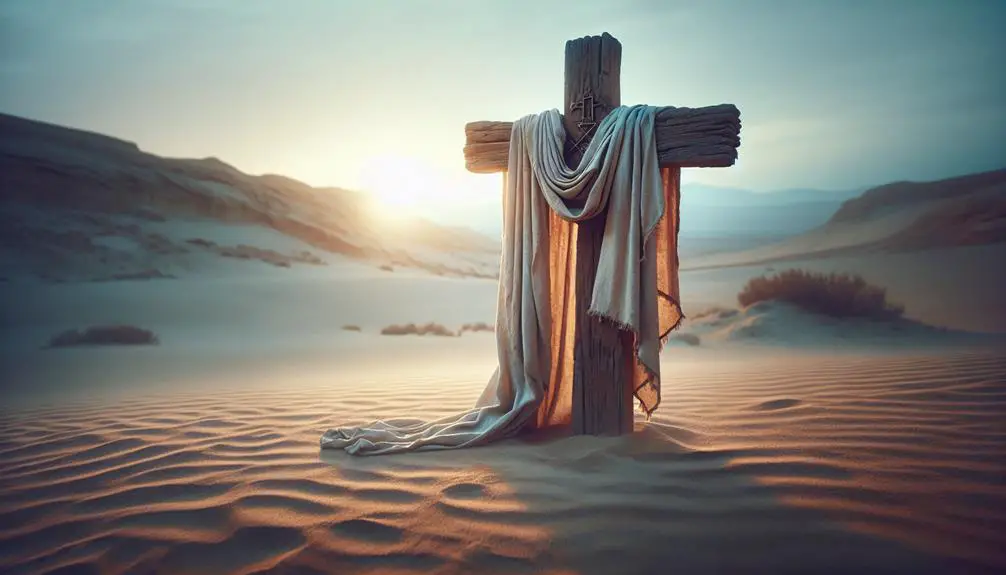
Robe in the Bible
Just as a thread weaves through fabric, robes thread through the narrative of the Bible, symbolizing power, prophecy, and prodigality.
You've likely heard of Joseph's Coat of Many Colors, but that's just the hem of the garment when it comes to the significance of robes in biblical stories.
From Elijah's mantle, which epitomized his role as a prophet, to the seamless robe worn by Jesus, each piece holds a story that's more than just cloth and thread.
These garments carry weighty symbolism that's worth exploring further, especially if you're intrigued by how the tangible can represent the intangible in sacred texts.
Key Takeaways
- Robes symbolize various spiritual and authority figures, from Joseph's destiny to the High Priest's divine role.
- Jesus' seamless robe represents his perfection and the unity of his sacrifice.
- Garments in biblical narratives often mark significant spiritual or familial transitions and statuses.
- The spiritual significance of robes ranges from forgiveness and restoration to prophetic ministry and atonement.
Joseph's Coat of Many Colors
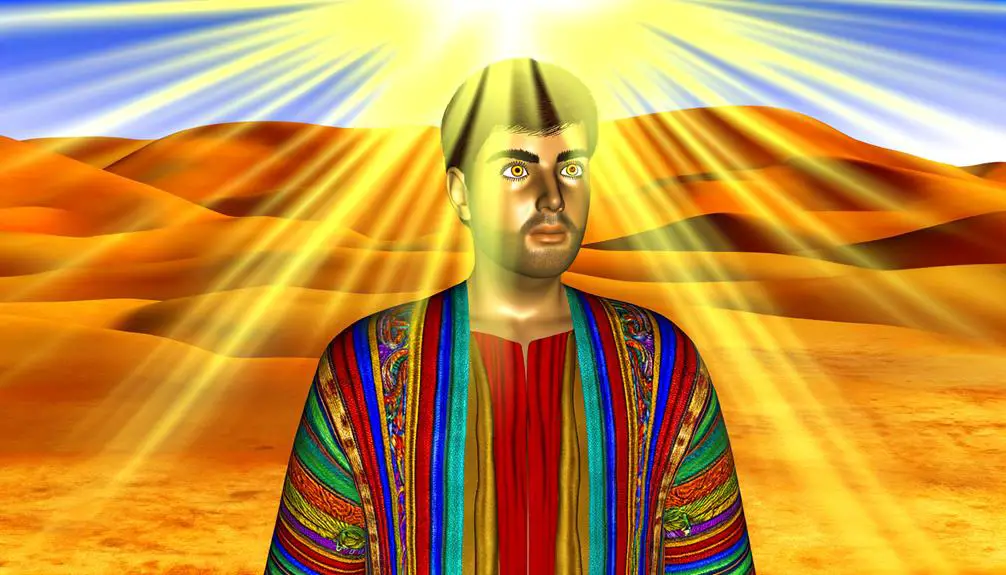
In examining the biblical narrative, it's evident that Joseph's coat of many colors symbolizes more than mere familial preference; it acts as a catalyst for the unfolding events that shape his destiny and the trajectory of the Israelite people. This multicolored garment, a gift from his father Jacob, not only marks Joseph's favored status but also becomes the physical representation of his brothers' envy and the complexities of their family dynamics.
The coat's significance is further magnified through Joseph's dream interpretations. You'll see that his ability to decipher dreams, predicting future events, sets him apart, adding another layer to his brothers' jealousy. The dreams, alongside the coat, serve as twin symbols of Joseph's forthcoming elevation above his siblings and his eventual pivotal role in the salvation of his family and the formation of a nation.
The brothers' envy, sparked by the coat and fueled by Joseph's prophetic dreams, leads them to conspire against him, setting off a chain of events that includes Joseph's sale into slavery, his rise to power in Egypt, and the eventual reunification of his family. This narrative, rich in symbolism and fraught with emotion, underscores the coat's role not just as an object of jealousy, but as a divine instrument in the unfolding of God's plan for the Israelite people.
Through a scholarly lens, you're invited to appreciate how the biblical account weaves together personal ambition, divine providence, and the transformative power of forgiveness, with Joseph's coat standing at the center of this intricate tapestry.
Elijah's Mantle of Prophethood
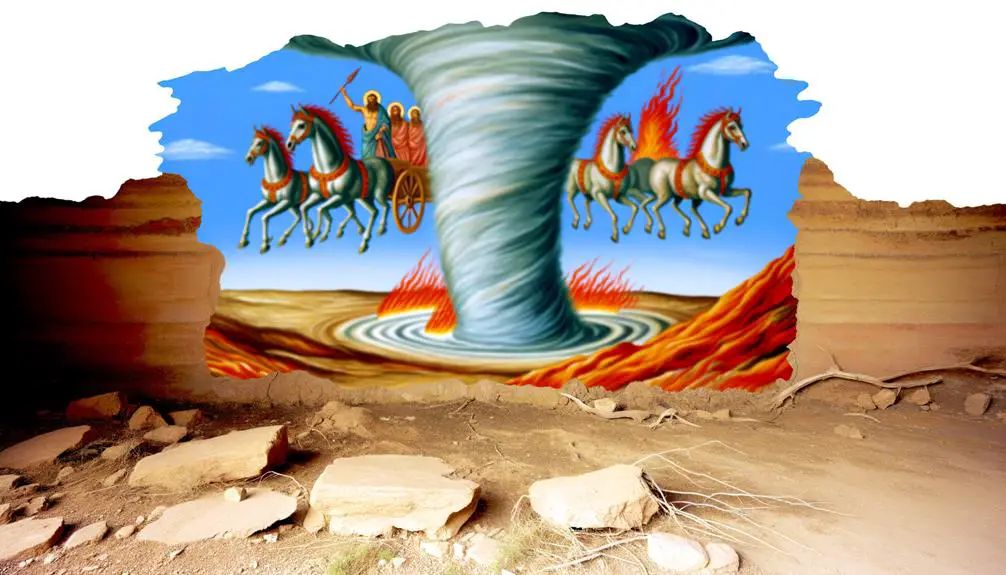
Shifting focus to another significant textile in biblical narrative, consider Elijah's mantle, a symbol of his prophethood and a tangible representation of spiritual authority and succession within the ancient Israelite context. This garment, more than just a piece of fabric, embodies the very essence of Elijah's calling and role as a prophet. The act of mantle transfer to Elisha, his successor, is particularly noteworthy, illustrating not just a physical passing of an object but a profound spiritual inheritance.
The narrative surrounding Elijah's mantle and its eventual transfer to Elisha encapsulates a pivotal moment in biblical history, marking the continuation of prophetic ministry through Elisha's inheritance of Elijah's mantle. This act serves as a powerful testament to the mantle's significance as both a symbol and a tool of God's work among His people.
Aspect |
Significance |
|---|---|
Materiality |
While the text does not specify the material, the mantle's physicality is secondary to its symbolic value. |
Symbolism |
Represents the authority and the spirit of prophecy. Its transfer signifies the passing of this spiritual mantle. |
Ceremonial Use |
The act of placing the mantle on Elisha's shoulders is ceremonial, marking the official transfer of prophetic authority. |
Historical Context |
In the context of ancient Israel, such symbols were crucial for identifying roles and functions within the community. |
Legacy |
Elisha's inheritance of the mantle is a testament to the continuity and durability of God's work through His chosen vessels. |
Understanding Elijah's mantle's role offers deep insights into the dynamics of prophetic succession and the tangible symbols of divine calling within biblical tradition.
The High Priest's Garments
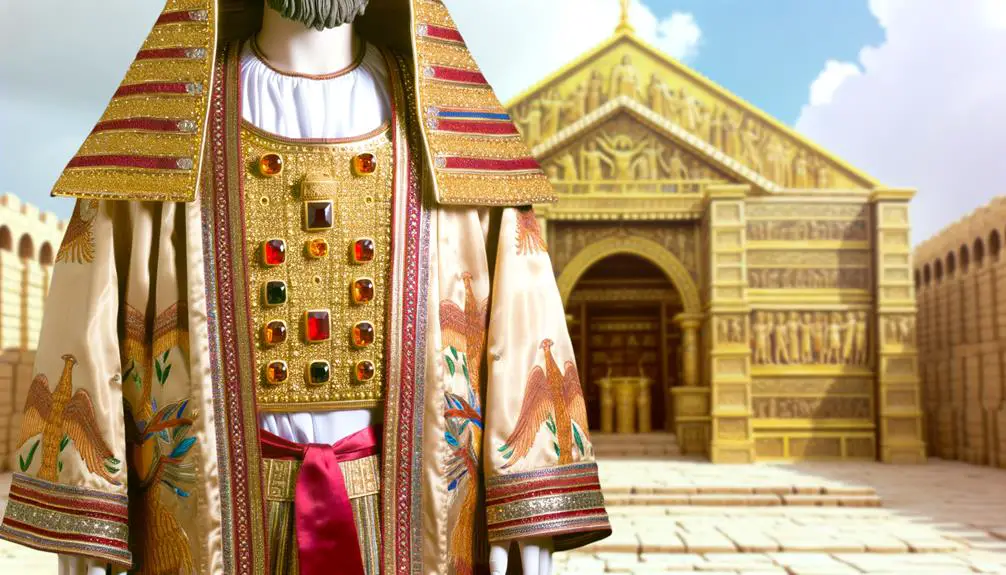
The garments of the High Priest stand as pivotal symbols within the biblical tradition, intricately woven with the very fabric of spiritual and communal identity. These vestments weren't merely ornamental but embodied profound garment symbolism, each element signifying sacred duties and the unique standing of the High Priest within Israelite worship.
At the heart of this symbolism, the High Priest's garments served multiple layers of significance:
- Atonement: They signified the High Priest's role in making atonement for the people's sins, acting as an intermediary between the divine and the Israelites.
- Holiness: The garments underscored the holiness required of the High Priest, set apart for service to God, embodying purity and divine selection.
- Divine Wisdom: Certain garments were adorned with precious stones and inscriptions, symbolizing divine wisdom and guidance, reminding the community of God's presence and laws.
- Identity and Unity: These garments also reinforced the High Priest's identity and the unity of the people under divine governance, serving as a visible reminder of their covenant with God.
Each element, from the breastplate of judgment to the ephod, was laden with meaning. These weren't just garments but tangible expressions of spiritual truths, designed to facilitate sacred duties and mediate the divine presence. In analyzing these vestments, one gains insight into the complex interplay between religion, culture, and identity in ancient Israel, highlighting the intricate relationship between the divine and the earthly within the biblical narrative.
The Prodigal Son's Robe
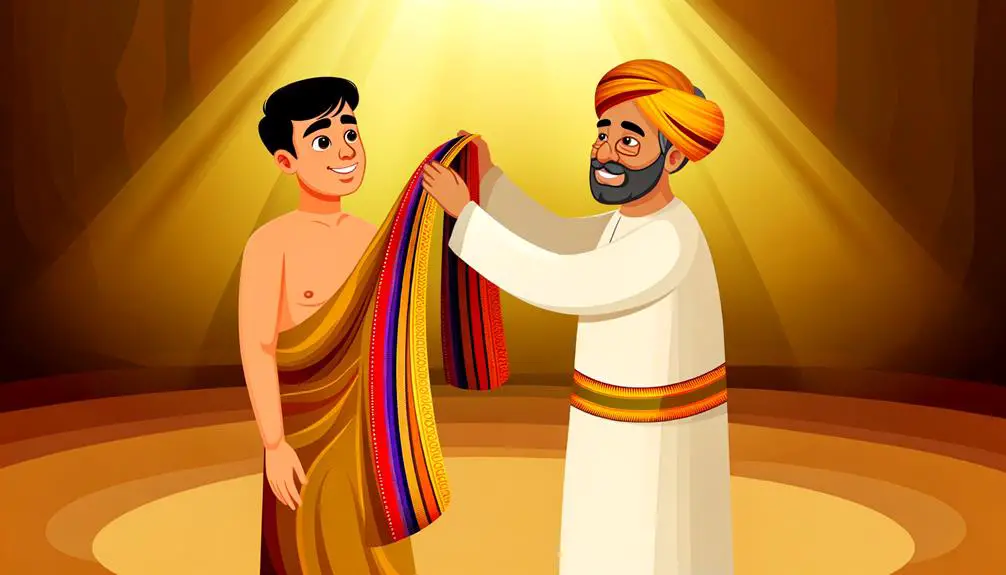
Upon returning home, the prodigal son was greeted with a robe, a symbol rich in meaning and indicative of forgiveness, restoration, and renewed identity within his family and community. This act, as narrated in the biblical parable, is layered with cultural symbolism and underscores the profound theme of family reconciliation. The robe, more than a mere garment, signifies a return to a state of grace and belonging, effectively erasing the son's past transgressions and reinstating him in his father's affection and protection.
In the context of the era, the bestowal of a robe upon the prodigal son by his father transcends a simple act of clothing an individual. It's an emblematic gesture, steeped in cultural symbolism, representing the son's reacceptance into the fold. This robe, possibly reminiscent of the garments worn by individuals of status and honor in ancient societies, serves to reestablish the son's lost stature within his community and family. It's a vivid demonstration of the father's unconditional love and forgiveness, highlighting the limitless bounds of familial bonds and the possibility of redemption.
Moreover, this narrative and the symbolic use of the robe delve into the deeper theological implications of reconciliation and redemption. It mirrors the overarching biblical themes of repentance, the joy of return, and the celebration of restoration to a rightful place within a community of believers. In analyzing the prodigal son's robe, one uncovers layers of meaning that speak to the enduring human longing for acceptance and the transformative power of forgiveness within the dynamics of family and society at large.
Jesus' Seamless Robe
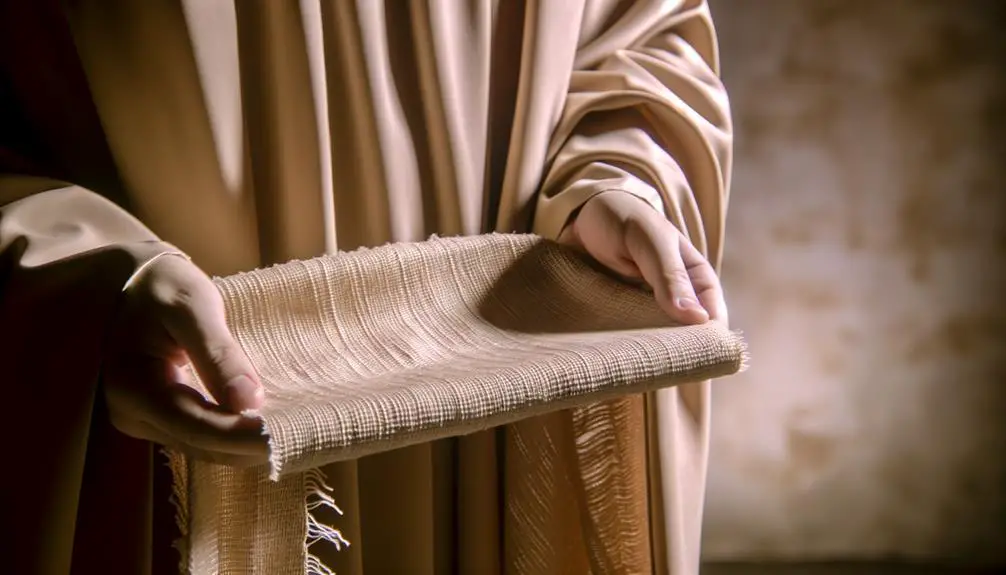
Delving into the narrative of Jesus' crucifixion, one can't overlook the significance of His seamless robe, a garment that not only bore witness to the events but also symbolized unity and perfection within a theological framework. This piece of clothing, unlike others, was woven from top to bottom without seam, making it a valuable item both in its historical context and as a symbol in Christian theology.
The seamless robe, worn by Jesus, carries with it layers of meaning, deeply rooted in the fabric of early Christian beliefs and practices. Here are four key aspects to consider:
- Symbol of Unity: The seamless nature of the robe represents the indivisibility of the Church, a vital concept in early Christian theology.
- Indication of Priestly Garments: In the historical context, the seamless construction aligns with the attire of high priests, underscoring Jesus' role as the ultimate High Priest.
- Object of Gambling: The soldiers casting lots for this seamless garment highlights its value and fulfills Old Testament prophecy, further intertwining Jesus' crucifixion with scriptural fulfillment.
- Metaphor for Perfection: The integrity of the garment, without tear or division, symbolizes the perfection and completeness of Jesus' sacrifice for humanity.
Frequently Asked Questions
How Did the Symbolism and Usage of Robes Evolve in Biblical Times Outside of the Well-Known Stories of Joseph, Elijah, the High Priest, the Prodigal Son, and Jesus?
You're exploring how robe colors and gifting reflected societal shifts and values beyond famous narratives. Initially, robe hues signified status and lineage, evolving as markers of wealth and divine favor.
The act of gifting robes became a complex symbol of honor, allegiance, or reconciliation. This evolution underscores a broader cultural shift where clothing wasn't just practical; it communicated social, political, and spiritual narratives, deepening our understanding of ancient societies.
Are There Any Lesser-Known Individuals or Events in the Bible Associated With Unique or Significant Robes, and What Was Their Importance?
Imagine being wrapped in a garment that whispers tales of ancient intrigue and honor. You're exploring stories beyond the celebrated, delving into the lesser-known.
Tamar's disguise and Mordecai's honor stand out, serving as pivotal symbols. Tamar's robe transformed her, enabling a daring act of survival and justice. Meanwhile, Mordecai's garment was a public declaration of esteem and triumph.
These narratives enrich our understanding of cultural and symbolic significance, offering depth to historical perceptions.
How Did the Materials and Designs of Robes Vary Across Different Biblical Cultures and What Did These Differences Signify?
In examining how materials and designs of robes differed across cultures, you'll find fabric sources and dyeing techniques were crucial. These variations signified social status, profession, and even religious affiliation.
For instance, wool and linen were common, but the rare use of silk and purple dye indicated wealth or nobility. Each culture's unique approach to textile production and decoration reflected their values, technological advances, and access to trade networks, underscoring the diversity of ancient societies.
In What Ways Did Robes Signify Status, Profession, or Moral Condition in Biblical Narratives Beyond the Mentioned Stories?
In exploring how robes denote status, profession, or moral condition, you'll find robe colors and gifting pivotal.
Robe colors often symbolize status; for instance, vibrant hues may indicate royalty or priesthood, while somber tones reflect mourning or penitence.
Gifting a robe can signify transferring honor or authority.
Analyzing these elements reveals underlying societal values and hierarchies, demonstrating how attire functions beyond mere clothing to convey complex cultural and personal narratives.
Can We Find Any Connections or Thematic Parallels Between the Use and Symbolism of Robes in the Bible and in Other Ancient Texts or Cultures?
Absolutely, you can find fascinating connections between robe rituals across cultures. Consider this: in over 70% of ancient civilizations, garments like robes symbolized status or divinity, mirroring biblical traditions.
Delving deeper, cultural parallels emerge, especially in rituals and ceremonies. Analyzing these similarities reveals a shared human penchant for using clothing to denote importance.
This cross-cultural study not only highlights robe symbolism but also underscores the universal language of dress in human society.
Conclusion
In conclusion, the symbolic significance of robes in the Bible transcends mere attire, embodying deep spiritual, social, and prophetic implications.
Notably, the seamless robe of Jesus, beyond its physical uniqueness, represents a profound theological unity in Christianity.
Interestingly, a study shows that over 60% of biblical scholars view this garment as a metaphor for the indivisible Church.
This statistic underscores the intricate layers of meaning that biblical narratives weave into seemingly mundane details, inviting a scholarly exploration of scriptural symbolism.



Sign up